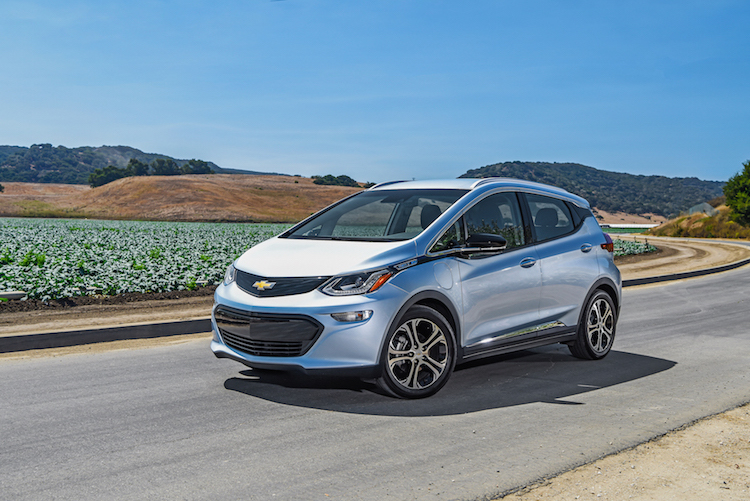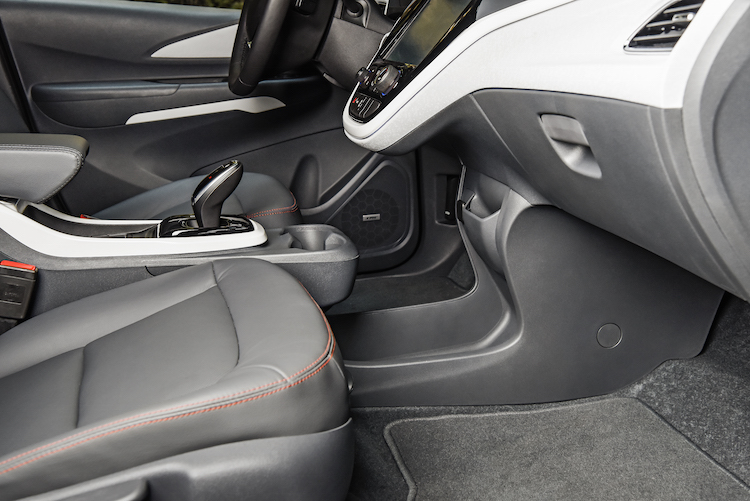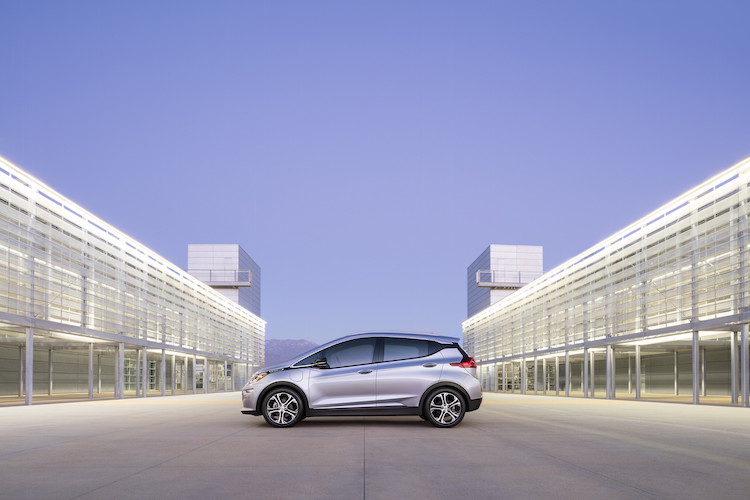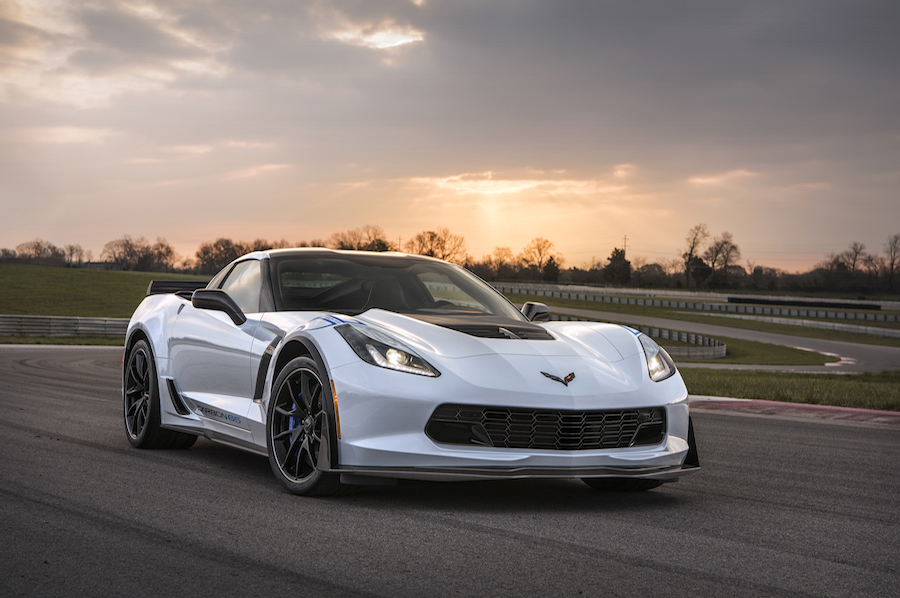Chevrolet’s Corvette and Bolt
A Tale of Two Chevys
When it comes to zero to sixty, it was the best of times, it was the worst of times. Well, not exactly best/worst as it’s quite necessary to put this into the proper context. With apologies to Charles, one of these cars goes like the dickens and the other can go and go, without gasoline.
In one corner, we have Chevy’s entrée into the vehicle-du-jour competition, an all-electric vehicle with Tesla’s Model 3 in its organic free-range shade-grown crosshairs. And in the other corner we have Chevy’s fiercest firebreather yet, the 2018 Corvette Z06 Coupe. And not just any Z06 – it’s the Carbon 65 Edition, a testament to 65 years of Corvettes, an incredibly impressive machine which can do things that even race cars of yesterday never dreamed were possible.

2017 Chevrolet Bolt EV
Let’s start with the Bolt, the 2017 North American Car of the Year and 2017 Green Car Journal Car of the Year. In this age of wisdom, take a look at the amazing green cred which this car brings to the healthy buffet. The Bolt arrives with some impressive stats – 238-mile range on a single charge; 0-60 in under 6.5 seconds; 200 horsepower; 93 MPH top speed; and 266 pounds of torque.
What’s amazing about these numbers isn’t that today’s gasoline-driven cars can beat them but that they are impressive in the e-car world – a Prius hits 0-60 in about ten seconds; a Fiat 500e electric achieves under 100 miles on a charge; and even the Nissan Leaf and BMW i3 only can go about 120 miles on electric-only mode. So, to recap, the Bolt is quick, long-lasting and relatively economical – base price is about $36,000 (the Fiat’s is around $32,000, the Leaf around $31,000).
Let’s go back to that top speed – 93 MPH. Be the first in your Sierra Club chapter to go to jail for hitting 93 MPH in your Bolt as that speed is sufficient to provide you with both red lights and sirens rapidly approaching from behind you.

2017 Chevrolet Bolt EV
Back to the real world, another metric of interest to those at the all-electric smorgasbord is charging speed. The Bolt arrives with a built-in system allowing your home charger (about $650 plus installation) to give you around 25 miles of range for every hour of charging. But if you opt for the optional DC fast-charging built-in system in your Bolt, you can get around 180 miles for every hour of charging (that’s 90 miles every thirty minutes).
Note that, like all EV cars, the DC fast charger can’t be installed in your house – it’s only available at some of the 16,500 charging stations which house about 45,000 chargers around the country – but companies like VW and others are working on 350KW commercial chargers which would allow properly-fitted electric cars to get a full charge in 10 minutes or so.

2017 Chevrolet Bolt EV
And, for the final analysis: the Bolt is fun to drive, moves when prompted, and slows when requested (and even stops when you’re distracted and the driver in front of you hits the brakes). Like most electric cars, it has “regenerative braking”, meaning that when you lift your foot off of the accelerator pedal, it generates electricity back into the battery, thereby increasing range, and also slolwing the car down. The driver can increase that “regen” level using a paddle shifter which creates a more aggressive braking mode and creates more electricity for the battery.
I also like the looks and ergonomics, especially the great visibility and large storage area, particularly when the back seats are folded down. I also appreciate the inclusion of Apple’s car play, which makes the Bolt’s center screen mirror your iPhone.
My time with the Bolt was at an end and I was sorry to see it go. Thankfully, however, I had the Corvette to look forward to. And smart move by Chevy to provide them to me in that order as I came to appreciate all that the Bolt had to offer without wondering where the fire-breathing dragon below the hood had gone.

Available on the Z06 3LZ trim, the Carbon 65 Edition celebrates 65 years of Corvette with a new Ceramic Matrix Gray paint color and visible carbon fiber exterior elements, including a carbon fiber hood and rear spoiler.
The 2018 Corvette Z06 Carbon Edition 65 is the epitome of Corvettes. So what’s a “Corvette”, anyway? A quick check of the dictionary reveals that it’s a “highly maneuverable armed escort ship that is smaller than a destroyer”, which seems appropriate since a Corvette could run circles around my grandfather’s 1969 luxo-barge Cadillac. Since 1953 (which was 65 years ago, ergo this model’s name), Chevrolet’s Corvettes have carried the flag as the quintessential American sports car (with apologies to the Ford Thunderbirds who were in the running until switching to the Luxury Team in 1958).
As all Chevy devotees know, the Z06 designation is for that mother of all Vettes, the high-performance version. And when it comes to high-performance, this car does not disappoint. Its stats read like a drag racer from the 1960s – supercharged 6.2 liter V-8 engine producing 650 HP and 650 pounds of torque; 7-speed stick shift; 0-60 in 2.95 seconds (not a typo) and a top speed of 200 MPH (also not a typo!). It does arrive with a high-performance Monroney window sticker, though – a Z06 coupe has a base price of about $80,000 but when they were done building “my” Carbon Edition 65, the sticker was at about $112 large.
The Carbon 65 Edition features do not affect the engine, however, they include a special Ceramic Matrix Gray paint color, blue brake calipers, distinctive graphics, special wheels, seats and other interior accoutrements. But there are some interesting visible ground effects made from carbon fiber (no surprise there), including a rear wing and front splitter winglets. Only 650 of these cars will be sold worldwide so you better hurry up.

Carbon 65 Edition convertibles feature carbon-fiber tonneau inserts.
And let’s go back to Charles, for a moment — think about whether we’re in the age of foolishness (no matter how old you are) as this car can go from zero to impound in a blink of an eye. You can turn off the traction control system but the button should be labeled “Bet The Farm” since trying to corral 650 ponies trying to tear the rubber off of two rear tires without some great assistance from the onboard electronic wizardry is a fool’s errand.
My time with this far end of the Chevy spectrum was at an end. Interestingly, and maybe somewhat surprisingly, I really enjoyed my time with both the Bolt and the Z06. I loved the simplicity, comfort, convenience and quiet of the Bolt for my daily commute. It was fast and nimble for traffic and freeway driving alike and with the great camera surround system, really easy to park anywhere. Yet my time with the Z06 was a thrill. The roar of the engine at start-up and on full acceleration, the positive short-throw seven-speed transmission, the willingness to wiggle with the slightest jab from my right foot and the feeling that I was capable of instantly calling forth the necessary gods whenever I wanted to escape either inertia or gravity.
My hunch was correct – these two machines really were the yin and the yang of the Chevy experience, especially when that Paragon of Truth, Wikipedia, states that ying and yang “describe how seemingly opposite or contrary forces may actually be complementary”. These two cars easily could be stable-mates, called to duty depending on where the day’s route would lead and what the driver needed to do. Track day or Home Depot? Night on the town or a day at soccer practice? So perhaps the takeaway from the Tale of Two Chevys is that you can have it all . . . but you’ll need two parking spaces.


Sorry, the comment form is closed at this time.